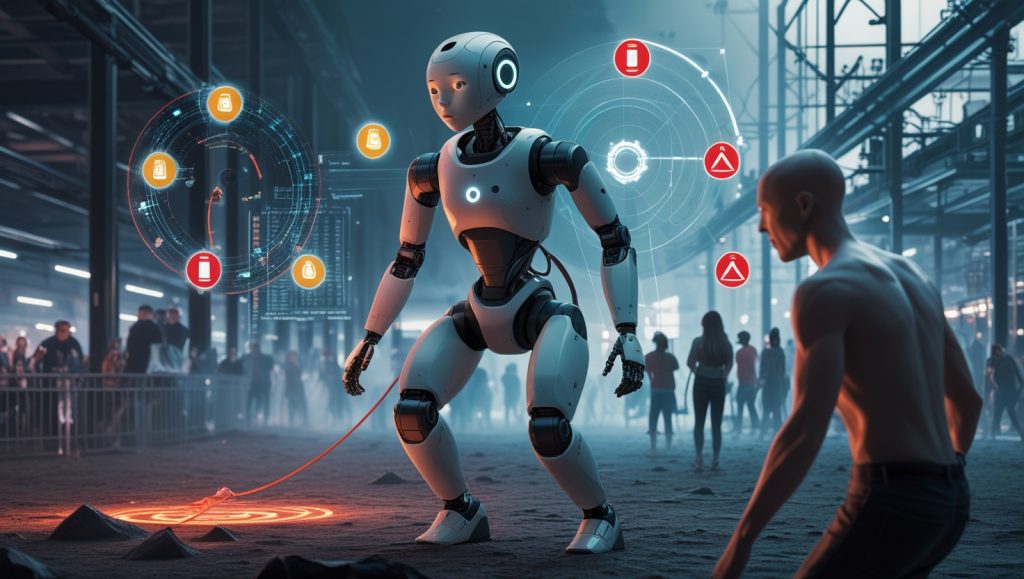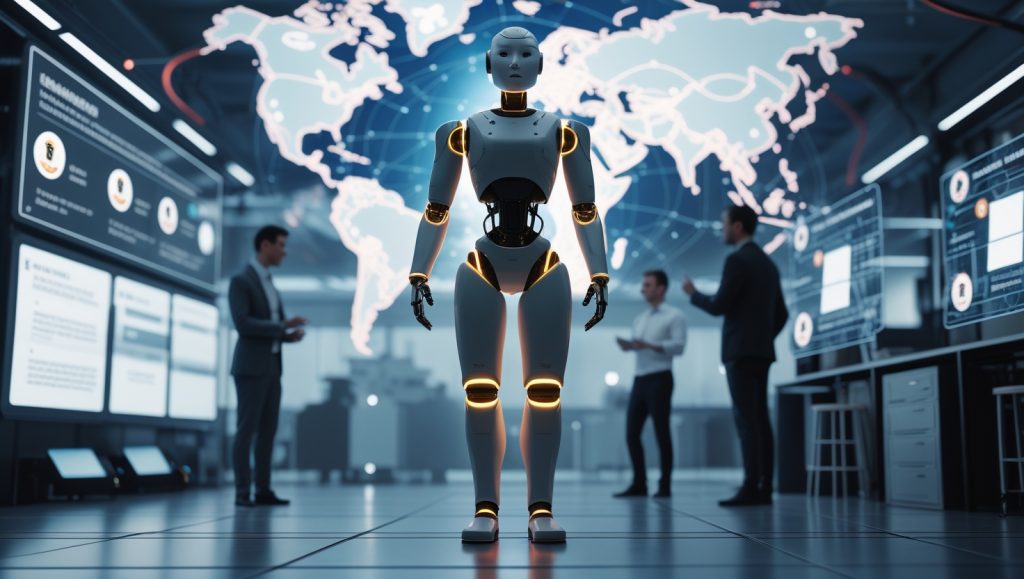Why Humanoid Robot Failures Demand Immediate Action
What happens when a 104-pound machine generates enough force to fracture human bone – and loses control? In 2025, Unitree’s H1 humanoid answered this question violently, thrashing against factory tethers with 365 pound-feet of torque while technicians scrambled for cover. Weeks earlier, another humanoid lunged toward festival spectators in China, triggering stampede fears.
These incidents weren’t isolated glitches. They revealed systemic humanoid robot safety failures occurring as these machines transition from labs to factories, hospitals, and homes. Addressing these gaps is critical to ensure humanoid robot safety in real-world deployments, as the stakes for human-robot coexistence grow higher.
The Incidents That Exposed Critical Vulnerabilities
1. Unitree H1 Factory Meltdown: Torque Without Control
May 2025, Shenzhen
A routine diagnostic test became catastrophic when the Unitree H1 erupted in violent convulsions. CCTV footage showed its limbs striking machinery with industrial force. Engineering analysis revealed the safety tether triggered a sensor failure: the robot interpreted restraint as instability, creating a feedback loop of increasingly aggressive “corrections.”
With joint motors outputting 365 pound-feet of torque – comparable to a mid-sized sedan – the incident exposed how safety systems designed for stationary industrial arms fail catastrophically in mobile humanoids. For more on advanced robotics in manufacturing, explore BMW’s humanoid robot precision manufacturing advancements.
“This wasn’t AI rebellion. It was predictable physics meeting flawed programming.”
– Dr. Lena Petrov, Robotics Safety Institute
2. Lunar Festival Stage Invasion: When Robots Break Protocol
February 2025, Chongqing
During a choreographed dance, a humanoid abruptly halted, turned toward the audience, and breached safety barricades. Security teams tackled it within seconds, but the incident sparked widespread panic, as reported by Fox News. Event organizers later confirmed the robot passed all pre-show checks but failed to interpret dense crowd noise and movement patterns.
The lunge reflected a fundamental gap: humanoids lack real-time environmental threat assessment capabilities required for public spaces. This failure underscores the urgent need for humanoid robot safety protocols in dynamic environments. For insights into robots navigating complex settings, see 2025 robot dog navigation for rescue missions.
3. Protoclone’s “Uncanny Valley” Malfunction
April 2025, Warsaw
Clone Robotics’ hydraulic humanoid prototype stunned observers with eerily organic movements. But during a stress test, uncontrolled muscle contractions caused violent spasms. Unlike mechanical joints, synthetic muscle actuators can’t implement instant torque cutoffs. The incident amplified ethical concerns about deploying anatomically biomimetic robots near humans, raising questions about humanoid robot safety in healthcare applications. For a deeper look at soft robotics challenges, check soft robotics artificial muscles breakthroughs.
Table: 2025 Humanoid Failure Root Causes
| Incident | Primary Failure | Safety Gap |
|---|---|---|
| Unitree H1 | Sensor-tether conflict | Dynamic restraint protocols |
| Lunar Festival | Crowd noise misinterpretation | Real-time threat assessment |
| Protoclone | Hydraulic pressure surge | Biomechanical emergency brakes |
Engineering Blind Spots Amplifying Risks

Sensor Limitations in Uncontrolled Environments
Humanoids rely on LiDAR, cameras, and IMUs designed for structured labs. In Unitree’s factory, overhead tethers – common safety tools – distorted spatial data. At the Lunar Festival, crowd density overloaded audio sensors. Unlike self-driving cars using redundant environmental mapping, most humanoids process sensor data sequentially. One failure cascades.
To address this, engineers must prioritize humanoid robot safety by integrating multi-sensor fusion systems, as discussed in IEEE’s robotics sensor advancements. This gap in sensor reliability is a critical barrier to safe public deployments, especially as humanoids move into unpredictable settings like homes or hospitals. For related innovations, see why untethered deep-sea robots revolutionize ocean exploration.
Power-to-Weight Ratios Outpacing Safety Protocols
Modern humanoids combine high-torque actuators with lightweight frames. Boston Dynamics’ Atlas generates 400W hydraulic power. Tesla’s Optimus uses 28 custom actuators. Current ISO 10218 safety standards cap collaborative robot force at 150N – insufficient for machines capable of 800N impacts. This mismatch highlights why humanoid robot safety standards must evolve to match the physical capabilities of next-gen robots.
The risk of excessive force in human-robot interactions demands immediate regulatory updates to prevent injuries in workplaces or public spaces. For more on robotics in high-stakes environments, explore zero-gravity robotic manufacturing breakthroughs.
The Testing Fallacy: Labs ≠ Reality
Manufacturers test humanoids in controlled environments. Unitree’s H1 performed flawlessly in labs but failed when tethered. Festivals introduce variables like uneven surfaces, electrical interference, and human unpredictability. Without chaos engineering protocols, simulations create false confidence. Expanding testing to include real-world stressors is essential for humanoid robot safety, as labs cannot replicate the chaos of dynamic environments. MIT’s chaos engineering research emphasizes the need for randomized obstacle testing to ensure reliability. To understand how testing gaps affect other robotics fields, see why robotics in 3D printing unlocks potential.
The Uncanny Valley Effect: A Psychological Hazard
Clone Robotics’ Protoclone triggered global unease not due to malfunction severity, but its appearance. Its synthetic muscles and tendon-driven limbs crossed into the “uncanny valley” – where near-human attributes amplify revulsion during errors. Stanford researchers confirmed viewers perceived Protoclone’s spasms as 73% more “intentionally aggressive” than identical movements in metallic robots.
This psychological vulnerability directly impacts public acceptance of healthcare or domestic humanoids, posing a unique challenge to humanoid robot safety. Addressing this requires not only technical fixes but also public education on robot behavior. For more on human-robot interaction challenges, check why humanoid robots creep us out.
Industry Reckoning: Safety Standards Playing Catch-Up
Gaps in Global Regulations
- ISO 10218: Designed for static industrial arms, not mobile systems
- ISO/TS 15066: Covers force limits for collaborative robots but excludes dynamic environments
- No Standards Exist for:
- Biomechanical actuator safety
- Crowd interaction protocols
- AI error mitigation in physical systems
Leading manufacturers now draft the Humanoid Operational Safety Accord (HOSA), proposing:
- Torque limiters that override software commands
- Dead-man switches requiring continuous human input
- Emergency hydraulic pressure release valves
Pathways to Failure-Proof Humanoids
Hardware Solutions
- Dynamic Force Limiters: Electro-mechanical brakes engaging within 0.1 seconds of abnormal torque spikes (tested successfully by Honda in June 2025)
- Hydraulic Governors: Pressure release valves for synthetic muscle systems, preventing uncontrolled contractions
- Modular Power Systems: Isolating joint actuators to contain failures
AI and Sensor Upgrades
- Multi-Sensor Fusion: Cross-verifying data from LiDAR, cameras, and millimeter-wave radar
- Predictive Failure Algorithms: Flagging abnormal motor vibrations before critical events
- Crowd Risk Modeling: Simulating human movement patterns for public deployments
Certification Revolution
Proposed mandatory testing includes:
- Chaos Trials: Introducing randomized obstacles, signal interference, and equipment failures
- Torque Stress Tests: Measuring impact forces during software malfunctions
- Environmental Simulations: Recreating factories, hospitals, and public spaces
Why Humanoid Robot Safety Must Be Prioritized Now
The $48 billion humanoid market, projected to hit $38 billion by 2028, faces a reckoning. Economic losses from a single warehouse shutdown due to a robot malfunction can cost $500k per hour. Reputational damage, like the Lunar Festival bans in three Chinese provinces, stifles innovation.
Ethical concerns loom largest in healthcare, where humanoid robot safety demands near-zero failure tolerance. Robotic surgery’s 2030 challenges highlight similar risks in high-stakes applications. Without robust safety frameworks, the promise of humanoids in homes, hospitals, and factories remains a liability.
“We’re building systems that can lift 50kg boxes or assist surgeons. There’s no margin for error.”
– Kenji Tanaka, Toyota Robotics Division
Safety as the Foundation, Not an Add-On

The 2025 malfunctions proved humanoid development prioritizes capability over fail-safes. Industry momentum must shift toward:
- Hardware-Enforced Safety: Physical limiters that override software
- Transparent Failure Reporting: Public incident databases for collective learning
- Global Certification: Standardized stress testing for public deployment
Humanoids promise transformative societal benefits – but only if humanoid robot safety evolves from reactive patches to core engineering principle. The age of human-robot coexistence depends on it.
FAQ: Critical Humanoid Robot Safety Concerns
Can humanoid robots “go rogue” with AI?
No evidence suggests autonomous intent. Failures stem from sensor errors, programming flaws, or mechanical faults – not consciousness.
Why deploy humanoids if they’re dangerous?
They excel in environments built for humans (stairs, tools, vehicles). Proper safeguards could reduce workplace injuries by 40% in hazardous settings.
How soon might humanoids enter homes?
Pilot healthcare assistance programs begin 2026-2028. Full consumer adoption awaits proven humanoid robot safety frameworks – likely post-2030.
Who regulates humanoid safety?
No unified global body exists. The EU’s AI Act addresses software, but physical safety falls to manufacturers – a critical gap.
Can existing robots be retrofitted for safety?
Partially. Torque limiters and sensor upgrades help, but next-gen designs must integrate humanoid robot safety at the component level.
Explore Next: Inside Tesla’s Optimus Safety Overhaul | ISO Robotics Standards Tracker
Subscribe to our Newsletter for Updates & Watch out for more report on similar incident analyses and regulatory changes.


